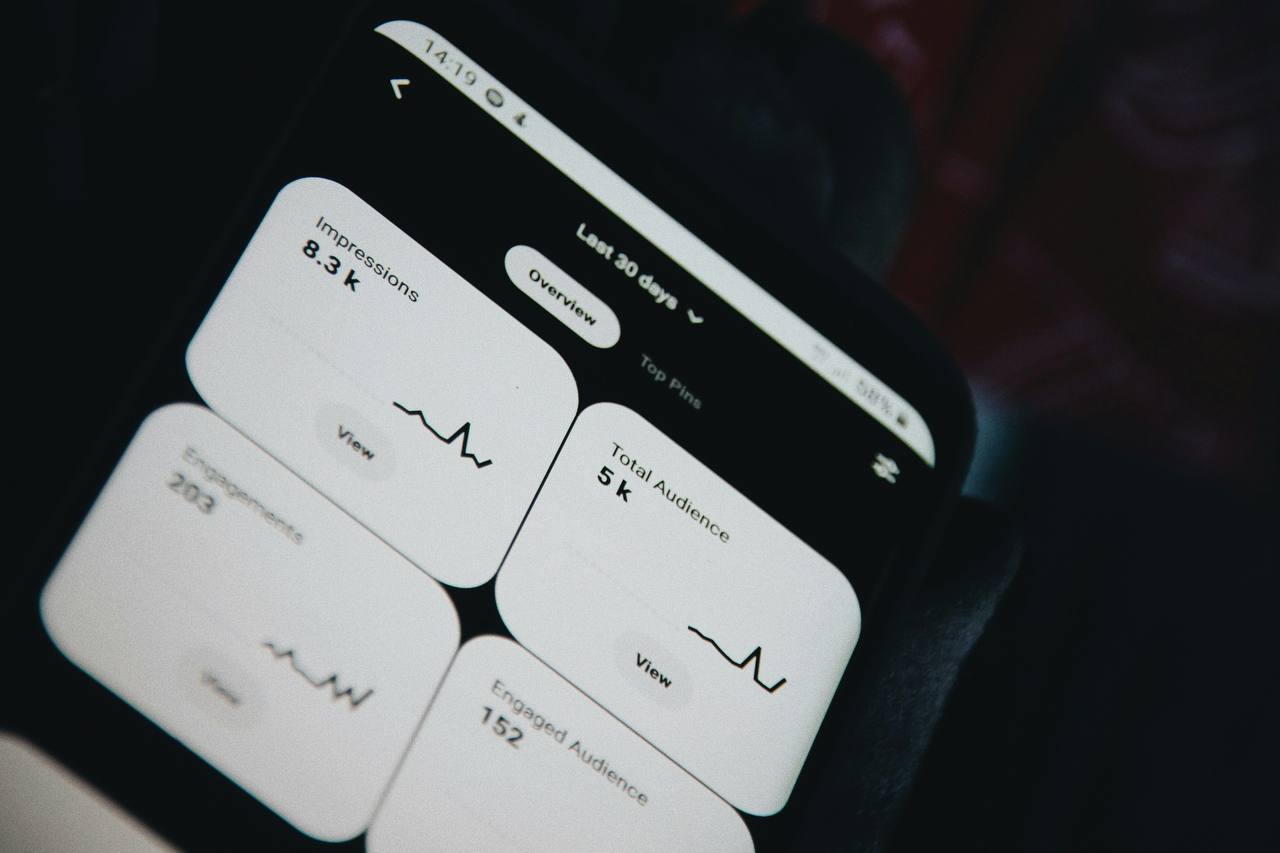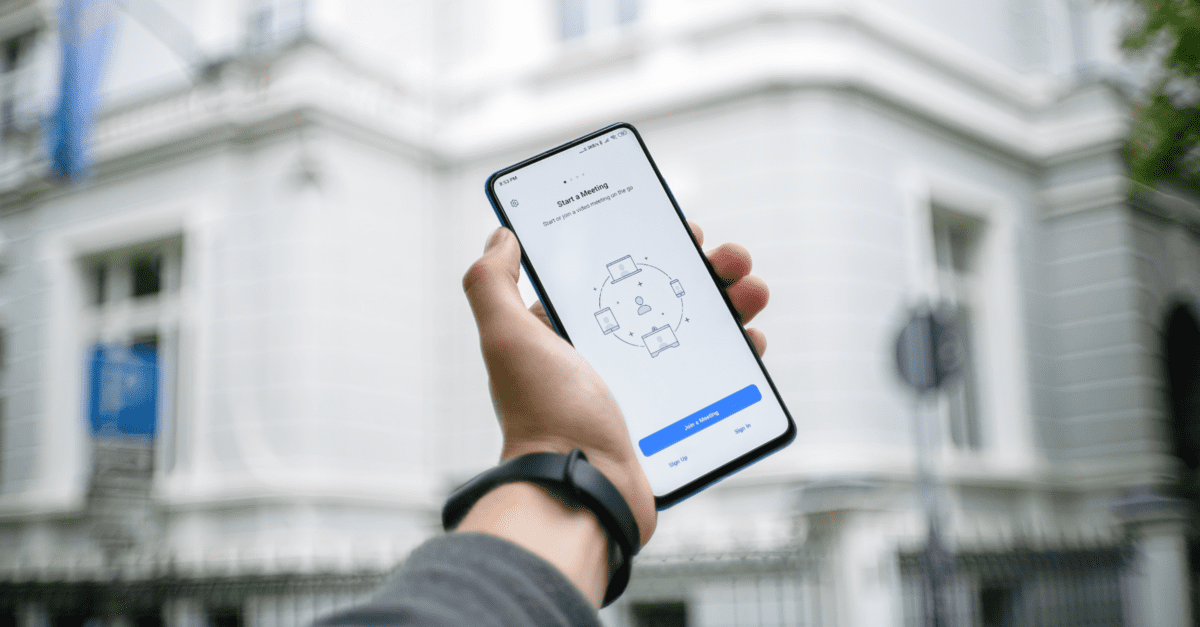Digital product design and development: General overview
Did you know that 49% of businesses do not have a consistent digital product management process? It’s no surprise that 21% of them fail to build solutions that meet the demands of their customers! Designing and developing digital products is a complex process, which is why it is critical to approach them logically, i.e., with a comprehensive plan.
In our article today, you will learn how the digital product design and development process should go and the main stages you need to go through to create a precious and worthwhile digital product.
What is digital product design?
Digital product design is the process of creating a product that offers a solution to a problem in a particular market. Successful digital product design responds to business and user needs. It includes digital media, experience design, and physical products.
The fundamentals of digital product design originate from the ideology of design thinking. It was designed as a customer-centric way to integrate real users’ needs into technology and business requirements. This allowed companies to solve rather complex problems.
The design thinking process is often used in product design. It consists of five steps that meet the needs of the user:
- Put yourself in the client’s shoes.
- State the problem.
- Generate new ideas.
- Create prototypes.
- Do some testing.
What is digital product development?
The development and launch of a new digital product that is focused on the end user is part of the digital transformation of a business. This is one of the effective strategies for adapting the business to existing realities.
New digital products are the refinement of the idea, the development or structuring of the value proposition of the future product, the verification and validation of the idea, interactive prototyping, and the development and launch of the MVP.
Digital product development usually consists of such essential stages as front-end development, back-end development and QA. But we will talk about this later in our step-by-step guide.
5 key stages of digital product life cycle
Let us give some context before we get into the digital product design and development process in depth. Each digital product, in particular, goes through its own “journey,” defined as the product life cycle. It is organized into five distinct stages:
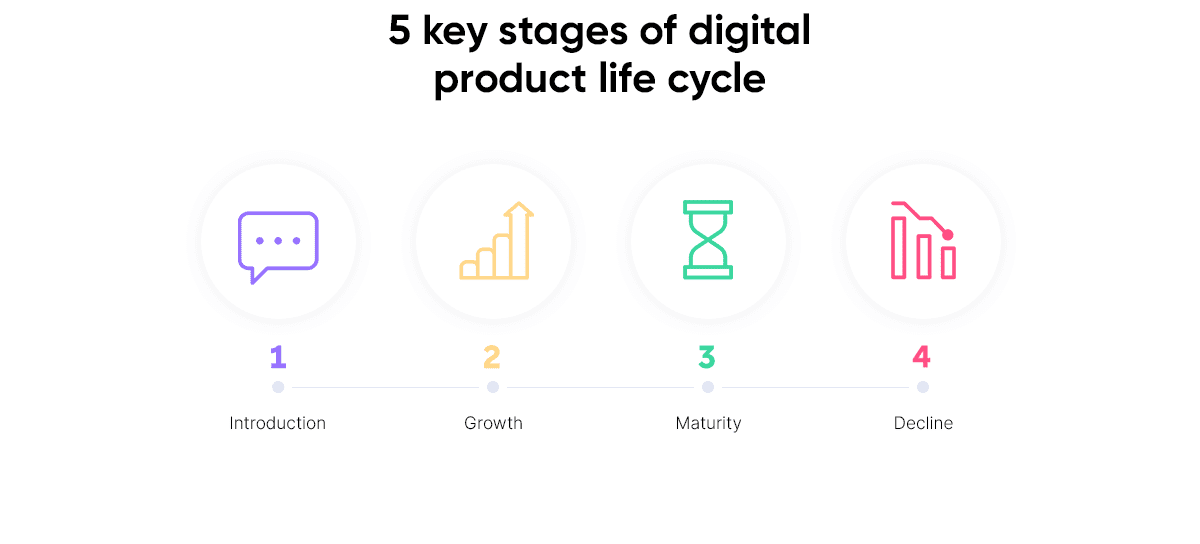

5 key stages of digital product life cycle
- When you initially bring a product to market and advertise it to potential purchasers, this is known as an introduction.
- Growth occurs after you’ve gained awareness and continued to expand your consumer base. Consider it the period when you’re riding the wave and maximizing the sales potential of your digital product.
- Maturity occurs when your product has attained its full potential. Your objective here is to extend the good fortune as long as possible.
- When the product’s user base continues to decrease, this is known as a decline. At this point, you may either withdraw it from the market or completely redesign it in order to stay afloat. All products expire, albeit numerous factors impact whether this occurs within a year, 10 years, or a hundred years!
Digital product design and development in 7 steps
In order for you to successfully carry out the digital product design and development process, we have prepared a step-by-step guide for you that will tell you in detail about each stage of the digital product design and development process.
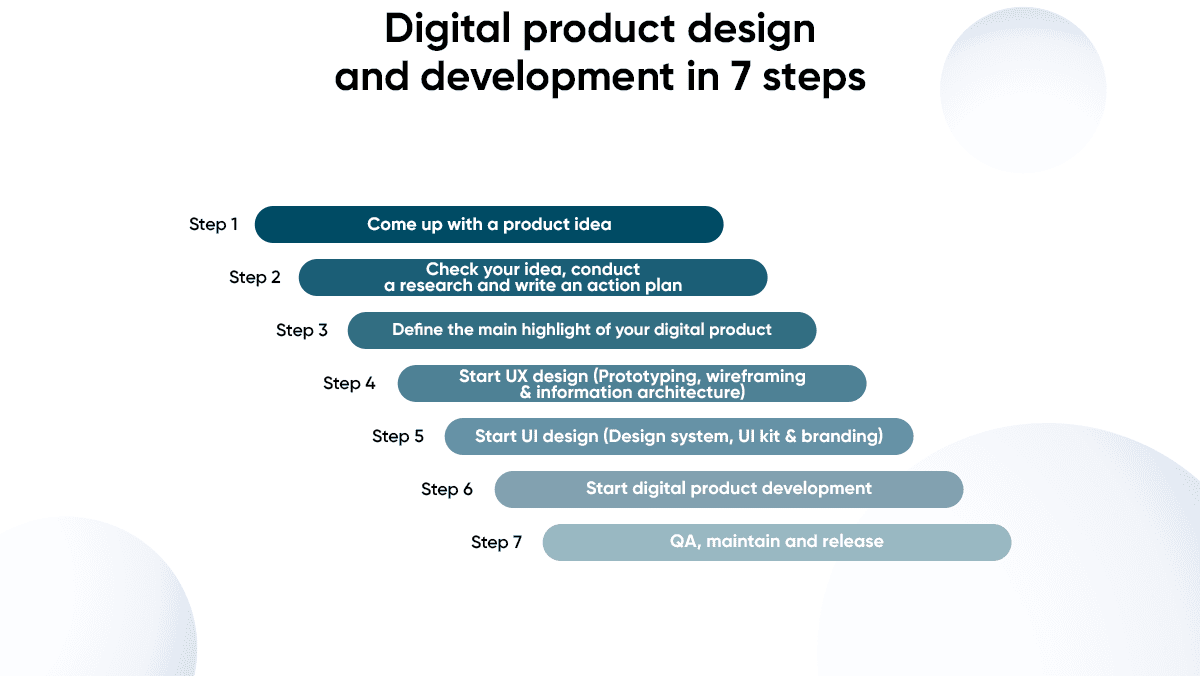

Digital product design and development in 7 steps
Step 1: Come up with a product idea
This step is the process of coming up with and discussing ideas. The aim here is to work as a group and allow yourself to unleash your creativity completely.
Here are the top three approaches you can take:
- Problem analysis entails attempting to comprehend the customer’s pain points, goals, and obstacles.
- Benefit structure analysis is determining the major advantages of a product concept and then evaluating which idea checks the most boxes.
- SWOT analysis, in which you examine the ideas’ strengths, weaknesses, opportunities, and threats.
Step 2: Check your idea, conduct a research and write an action plan
Next, you should test your idea. You can do this by conducting research to validate market demand for your product idea.
We also advise you to analyze competitors to identify their strengths and weaknesses for future borrowing for your product. Conduct a series of research aimed at general market research, the requirements of your audience and the possibility of developing your idea.
In general, thanks to this research, you will be able to:
- find out what projects already exist on the market;
- understand whether these projects are successful and whether they raised investments;
- find out if there are monopolists in the industry;
- study what technologies and requirements are facing these projects;
- find out what is the price for development services;
- understand what kind of team is needed for such a project.
After drawing conclusions from each analysis and research, draw up an action plan and describe in detail each process that you need to go through for successful digital product design and development.
Step 3: Define the main highlight of your digital product
At this stage, you should determine the principal value of your future digital product. This is necessary so that, firstly, customers who come to you can get exactly what they expect from the product. Secondly, this is necessary so that you direct all your efforts into one direction of development and not be scattered over many.
For example, if you are developing a marketing tool for email newsletters, then the main essence of your product will be the correct development of the main module of the product, namely the module that is responsible for the mailing automation mechanism. Remember, if the heart of your product works correctly, then the product itself will bring value to users.
Step 4: Start UX design (Prototyping, wireframing & information architecture)
Now you can start the digital product design process. Wireframing is the first step in the digital product design process, in which you sketch out a basic picture of the product’s architecture, outlining what occurs as users progress through the customer journey.
Following that, you’ll start making prototypes, usually with low-fidelity versions. You may return to creating high-fidelity wireframes after testing those prototypes and either validating or rethinking your strategy.
Step 5: Start UI design (Design system, UI kit & branding)
At this stage, you will need to create a design system or UI kit and collect all the visual components of your digital product in them. This step is also dedicated to choosing branding elements such as colors, fonts, logo creation, etc.
Spend enough time on UI design, as UI design is what will attract your future users and customers in the first place.
Step 6: Start digital product development
Next comes the stage of transforming the design and all your ideas into a functioning product. Simply put, the stage of digital product development is coming. Here are the steps the RewiSoft digital product development process consists of:
- Tech stack & documentation. The development team determines technologies that will be appropriate for your project. We compile technical documentation describing all features and functionality and the relationship between user roles.
- Software architecture plan. Developers create the basic structure of the product. On the back end, they choose whether it will be, for example, a monolith or microservices and choose the controllers and types of APIs they will use. On the front end, developers determine how the user interface will be implemented and schematically depict which parts of the product will interact with each other.
- Sprint planning. At this stage, we determine the priority and sequence of features creation. This stage is critical because the entire product development plan is based on it.
- Infrastructure setup for testing + CI/CD to the test servers. DevOps set up the production-like environment for running the developed application on the cloud. The customer has access to it and can also test the product. We configure the system so that all changes we make to the product automatically appear in this environment.
- Client and server development & QA. At this stage, client and server parts of the product are developed (development of UI components, API, etc.) and tested.
Step 7: QA, maintain and release
At this stage, QA tests the entire product thoroughly. The product team fixes bugs that may have appeared when they were adding new features and product components. After the product has been fully tested and all bugs have been fixed, you can release your product. The main thing to remember is that after the release, the product should be supported.
Start digital product design and development with RewiSoft
RewiSoft is a team of highly experienced digital product designers and developers. Our team can offer you a full digital product design and development cycle, from business analysis to post-launch support. Our team of designers and developers consists of middle and senior-level specialists. Our company makes every effort to ensure that our specialists grow, gain new knowledge and improve their skills.
RewiSoft team provides the following digital design services:
- Digital product UX design. Thanks to a modern approach, advanced technologies and deep knowledge in the field of UX design, we will turn your idea into a full-fledged, user-friendly and understandable digital product.
- Digital product UI design. We provide extensive design systems and UI kits that allow you to build the UI design of your dreams quickly.
- Digital web design. Our web design services may assist you in improving your search rankings, increasing your online visibility, and converting page visitors into paying clients.
- Digital mobile app design. From product concept through prototype and user testing, RewiSoft pays close attention to every step of the digital mobile app design process.
- Digital product redesign. RewiSoft digital product redesign services provide an opportunity to improve usability, increase client loyalty and experience, and improve your company’s image.
- Digital software design. We have the necessary skills in all design tools and technologies to create professional software designs that capture users’ attention and bring more clients to your product.
RewiSoft team provides the following digital development services:
- Digital product discovery. We can clearly identify the project’s goals, the scope of work, and restrictions, as well as analyze business prospects and produce a solution vision by collecting and evaluating information about your project, its market, and end users.
- Front-end development. Our skilled front-end specialists develop stunning, responsive layouts to help you stand out from the competitors and guarantee that your website or application operates properly across all browsers, operating systems, and devices.
- Back-end development. Our experts will provide excellent back-end digital product development services, as well as build logic and architecture for your future digital product and ensure that it runs properly.
- Digital web development. We will be accessible to assist you with all aspects of website creation, from planning to implementation. To develop and design websites, our development team is well-equipped with the newest technologies and industry best practices.
- Digital software development. RewiSoft is a full-cycle software product development company that offers end-to-end software development services, beginning with market research and business analysis and continuing with development, deployment, and post-launch support.
- Digital product QA. You will obtain a complete and actionable look at the success of your manual functional and automated testing in one spot, based on testing done at scale with actual users that match your customer characteristics.
If you are looking for a reliable team of professionals who can design and develop your digital product, contact us! Our team of professionals will help you at every stage of building a digital product.
Top things to consider for successful digital product design
During the digital product design process, you should pay special attention to the following things:
User-centricity
The user comes first in today’s digital business. Everything you develop should meet the user’s ever-increasing requirements and needs. Concentrate on developing products that comprehend:
- who your target market is
- what they truly want (they = target market)
- what issues do they encounter
- how you can assist them in overcoming them (them = problems).
Based on this knowledge (and all of the comments and data you’re receiving), refine your product accordingly. Because if you don’t, someone else will.
First value than features
A product that gives value to the digital experience will stand out more than one with features. A fascinating feature that distracts from your primary product is less significant than value.
Google’s homepage is an excellent example. The emphasis is on delivering value to the user. It’s simple to explore the internet, escape the ‘real world’ with the Google Doodle, or use your Google services. Google could do so much more with all that whitespace. However, doing so would diminish the site’s and service’s genuine value.
Design consistency and hierarchy
Consistency contributes to a smooth user flow. When you go across the pages of a website, the typeface, icons, colors, and page layout stay consistent. It doesn’t feel like you’re flipping through one, two, or fifty-four pages.
More significantly, consistency assists in the creation of intuitive user experiences as they explore your app or website. For example, the search bar is always at the top-left corner. A green check always indicates a positive response. They don’t even have to consider it.
Visual hierarchy allows you to direct the user’s attention to what is most important. Call-to-action buttons are huge and prominent for a purpose, while the menu symbol is three thin lines in the corner of the screen. Users will understand what the three lines mean if they require it, and they will know what action you want them to take.
User experience matters
We have all had digital experiences that put roadblocks in our path. The superfluous ‘give us your email’ form, pop-ups, and incomprehensible menus that simply complicate our journey. Digital product design – and user expectations – necessitate simplicity. Users want quick load times, simple navigation, and clear directions. This expands on the user-centric attitude, resulting in experiences that simply function. It’s as simple as that.
Top things to consider for successful digital product development
During the digital product development process, you should pay special attention to the following things:
Digital product architecture comes first
During digital product development, pay special attention to building a digital product architecture.
The content of the product should be divided into parts so that users can perceive it properly so that it is easy to find the product features for which users came to your site or application. Sometimes it is implemented so smoothly that users do not even notice that the information is organized especially for them.
Without proper content sorting, most of your users would get lost while navigating your website or app, and as a result, the value of your product would be questioned. After all, what is your great feature if users can never find it?
Right technical stacks
In order for your digital product to be of high quality and work in accordance with all technical norms and standards, you need to choose the right technology stack. Unfortunately, you are unlikely to be able to do it yourself. We recommend that you contact the experts.
Most often, the RewiSoft development team uses the following technical stacks for development:
- Front-end development: Angular.js, React.js, Vue.js, etc.
- Back-end development: Node.js, Python, Laravel, etc.
- Android app development: Java, Kotlin.
- IOS app development: Objective-C, Swift.
- Hybrid app development: Flutter.
If you want to know which tech stack is suitable for your project, contact the RewiSoft team today!
Compliance with all technical standards
Also, you should take into account all the technical and industry standards in digital product design and development. For example, if you are creating a digital product for the banking sector, you must comply with all norms and standards for protecting personal user data, encrypting banking transactions, using blockchain technologies, etc.
Also, study the technical standards for different types of products (website, mobile application, software, etc.) All of them have their own technical differences, so the approach to them should be different.
Private organizations such as the International Standards Organization (ISO), the American National Standards Institute (ANSI), and the International Electrotechnical Commission (IEC) establish design and development standards.
Standards may be found everywhere and have a significant influence on the economy. They offer:
- Security and dependability. Users view standardized products and services to be reliable, which boosts user confidence, sales, and technological adoption.
- Policy and legislative assistance from the government. Standards are used by regulators and legislatures to defend the interests of users and businesses.
- Interoperability and compatibility. Devices collaborate when items and services meet standards.
- Business advantages include market access, economies of scale, and innovation.
- Customers have a choice. Standards offer the basic building blocks for product creation and make competing items simpler to comprehend and compare. Standardized mass development makes a wider range of products and services available to customers.
Experienced development team
All experienced entrepreneurs and business owners know that a good team is key to the success of a project. Therefore, if you want your digital product design and development process to be successful, you need to hire a knowledgeable, skillful and, most importantly, experienced team of designers and developers.
You can find such a team using social networks such as LinkedIn, ranking sites such as Clutch.co, or portfolio sites like Behance. Also, you can contact us! We have many experienced specialists on our team who are ready to carry out your project in the best possible way.
The main challenges you may face during digital product design and development
You will likely encounter certain challenges during the digital design and development process. Let’s look at the most common:
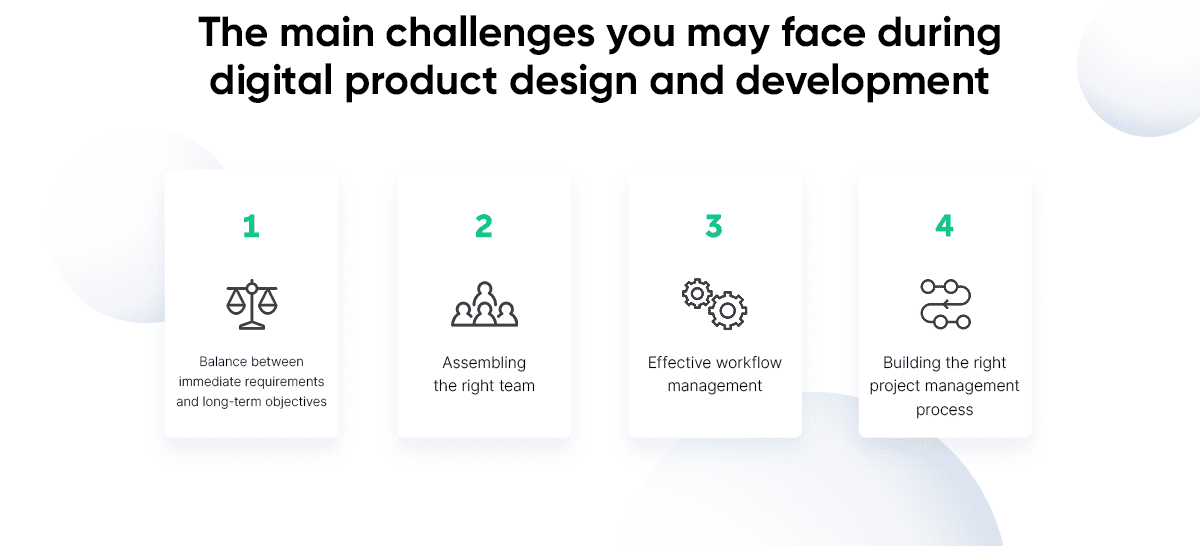

The main challenges you may face during digital product design and development
Balance between immediate requirements and long-term objectives
When it comes to product development, it’s tough to decide how much money to devote to short-term needs against long-term goals. While the initial costs of prototyping, research and other services might seem daunting, it is critical to consider the overall picture. Cutting shortcuts during product development will damage your company more in the long run.
Assembling the right team
Product development is a collective effort. That is why assembling the greatest product development team is critical. While this group can be created internally, some companies find it useful to collaborate with an outside team of specialists.
Whether your company decides to pursue the internal or external route, having well-defined marketing, sales, and product launch strategies is crucial for effective product development and project management.
The right team consists of the following members:
- Project Manager (PM)
- Business Analysts (BA)
- UX designer
- UI designer
- Design team lead
- Front-end developer
- Back-end developer
- Tech lead
- DevOps
- QA engineer
Effective workflow management
One of the most typical concerns and obstacles in product development is executives’ inability to manage workflow effectively. A team needs to collaborate properly to ensure the pace and quality of the final output are maintained.
A product manager must recognize the significance of getting everyone on their team on the same page. They must speak freely with all members of the team at the same time and settle any problems as soon as possible.
Building the right project management process
The failure to commercialize exceptional product ideas is largely due to a failure to structure and define the product management process effectively. Without the presence of a product owner, early brainstorming produces no results.
Even if the product owner is present, most activities will not occur until the procedures are adequately developed to move beyond the idea stage. The product owner must not only be technically competent, but also adhere to the major objectives of the product, such as customer happiness, profitability, and launch timing.
Best trends in digital design and development in 2023
In order to create a truly worthwhile, modern and sought-after digital product, you need to follow the latest trends and technological innovations. We have compiled a list of one of the most relevant trends in digital design and development in 2023:
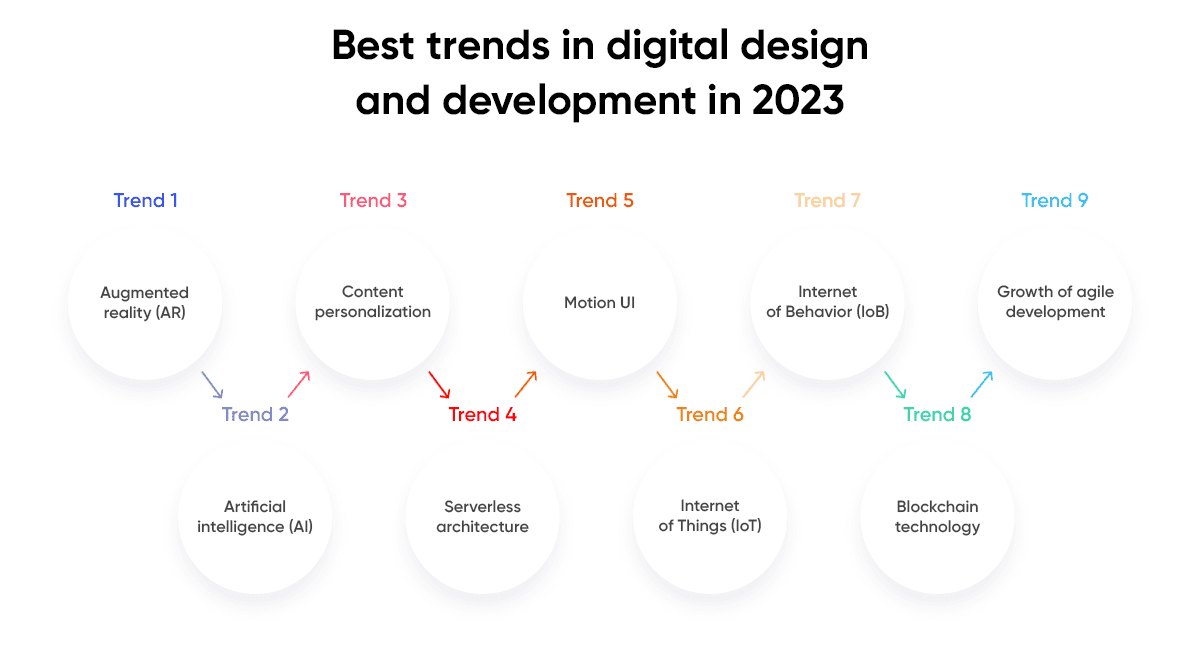

Best trends in digital design and development in 2023
Augmented reality (AR)
Augmented reality technology has infiltrated our daily lives. They’re found in mobile devices, education, healthcare, and video games. Statista predicts that the worldwide AR, VR (virtual reality), and MR (mixed reality) industries will grow from roughly $28 billion to $250 billion by 2028.
Artificial intelligence (AI)
AI assistants can learn, gather data, and handle difficult problems. This topic is widely regarded as one of the biggest technologies influencing the future of web development. As a result, community demand for AI-enabled communication will increase in 2023.
Content personalization
One of the most important digital product development trends for 2023 is personalization. It refers to the process of developing information that is relevant, entertaining, and valuable to users.
According to Twilio’s 2022 State of Personalization Report, 62% of people feel companies would lose their loyalty if they provided an unpersonalized experience.
Serverless architecture
Serverless computing, as one of the most intriguing current online technologies, offers several advantages. The following are the primary benefits of this approach:
- increased scalability
- reduced time-to-market
- cost-effectiveness
- delegated maintenance
Motion UI
Motion UI is a robust front-end framework that allows you to create configurable animated UI components. You can use it to create modular scrolling, backdrop animations, and animated charts. All of these, and many more components, can let you convey your individual style while also keeping your user amused. Motion UI proves to be even more useful in the design of progressive web apps.
Internet of Things (IoT)
Google Nest smart speakers are one of the most well-known IoT gadget examples. It is an intelligent IoT gadget that lets users control media, alarms, lighting, and other tasks with their voice.
Is it applicable to the sphere of digital product design and development?Without a doubt, the Internet of Things will enable enhanced communication between digital product design and operational models. Sensors, cameras, and signaling devices are prominent in the digital product design and development trend. It will guarantee that client requests are handled more effectively and that the most appropriate replies are provided.
Internet of Behavior (IoB)
IoB (Internet of Behaviors) is the natural next step after IoT. (Internet of Things). However, because the IoT connects devices in this category into a single network, the IoB allows data on individuals to be collected into a single database.
Blockchain technology
Blockchain is a fast-evolving online technology in software development. It also has the following advantages:
- reduces financial company expenses;
- reduces the number of transaction contracts;
- increases cash flow generated by clear records/data;
- intelligent prediction system;
- interactivity on websites is high;
- data protection;
- secure transactions.
Growth of agile development
The use of the agile approach is the next digital design and development trend. Agile digital product development is a method that many IT businesses utilize while developing applications.
Iterations are used to split the entire process of working on a web project with agile. These are two to three weeks long cycles. Each iteration focuses on a different set of duties. These duties include, for example, requirements analysis, design, programming, testing, and documentation.
The team examines the outcomes of each iteration and reprioritizes for the following iteration.
How to hire a great digital product design and development team?
As we said earlier, a good team is key to the success of any project. But where can you find such a team? We’ve put together some tips for you. Let’s look at them in detail:
Use famous social networks for digital product designers search
You can find experienced digital product designers and developers on social networks, for example, on LinkedIn. Here you will find detailed information about teams, companies that can provide you with digital product design and development teams, and their representatives. You will be able to evaluate the experience of specialists, the areas in which they work, the main industries, levels of expertise, etc.
Find out how teams handle the digital product design process
When you hire a digital product design and development team, be sure to find out how they handle the digital product design process. Find out what methods the team uses in working on projects, what their approach is, what tools and practices they use, etc.
Pay attention to both hard and soft skills
Be sure to pay attention to the personal qualities of your future specialists. Not only technical knowledge is essential (although it is also very important), but also communication skills. If your future digital design and development team does not find a common language with your in-house team, then you can not count on the success of your project.
Conduct detailed interviews and analyze portfolios
Of course, it is important to prepare well for the interview and ask as many detailed questions as possible. Here is a list of questions you can ask your future digital product design and development team:
- What is your experience in digital product design and development?
- What were your successful projects and what do you think is the main reason for success?
- What failed projects did you have and what do you think is the main reason for the failure?
- What technologies, tools or practices do you use in your work?
- What are your 3 strongest hard skills?
- What are your 3 strongest soft skills?
- and others.
Also, do not forget to analyze the portfolio of your future team. Find out what projects the team worked on, in what style the projects were completed, etc.
You can learn more valuable information and useful tips by reading our article How to Hire a Dedicated Software Development Team?
How much do digital product design and development cost?
The price of digital product design and development services depends on many factors. Before hiring a team, you should definitely analyze them. Among them, we highlight the following:
- location where the team is located
- team expertise level
- team experience
- project complexity
- number of features
- used technical stack
- used methodology and technologies
- and other factors.
To make it easier for you to calculate the cost of your project, take a look at the table that our team has created. Here you will find prices for various digital product creation processes in different regions:
How long do digital product design and development take?
The time you need to design and develop a product also needs to be calculated by taking into account factors such as the size of your project, its complexity, the number and complexity of functionality, design complexity, etc.
We have prepared a table for you with the help of which you can calculate the approximate time required for the digital product design and development process:
If you want to calculate exactly how long it takes to complete your project, get an estimate today!
Digital product design and development: Summary
While product creation is a complicated process, it does not have to be tough if you know how to approach it, as we have covered in this article!
We hope you are now eager to begin your product development adventure. Contact the RewiSoft team if you need a dependable team to assist you design and build a digital product!







